Housing Quality in the Italian PNRR: Analysis of PINQuA’s evaluation and design methodologies
Journal title ARCHIVIO DI STUDI URBANI E REGIONALI
Author/s Annunziata Palermo, Lucia Chieffallo, Maria Francesca Viapiana
Publishing Year 2023 Issue 2023/137
Language Italian Pages 24 P. 133-156 File size 204 KB
DOI 10.3280/ASUR2023-137007
DOI is like a bar code for intellectual property: to have more infomation
click here
Below, you can see the article first page
If you want to buy this article in PDF format, you can do it, following the instructions to buy download credits

FrancoAngeli is member of Publishers International Linking Association, Inc (PILA), a not-for-profit association which run the CrossRef service enabling links to and from online scholarly content.
Italy focused its attention on the housing issue through specific tools including the National Innovative Program for the Housing Quality (called PINQuA). Following the pandemic, it became a specific measure of the National Recovery and Resilience Plan. The paper provides an overview of the Program by making explicit the evaluation and design methodologies adopted. The aim is to facilitate the exchange of information useful for improving the performance of housing quality in other contexts.
Keywords: PINQuA; NRRP; DNSH; housing quality; urban regeneration.
Annunziata Palermo, Lucia Chieffallo, Maria Francesca Viapiana, La qualità dell’abitare nel PNRR italiano: analisi delle metodologie di valutazione e progettazione del PINQuA in "ARCHIVIO DI STUDI URBANI E REGIONALI" 137/2023, pp 133-156, DOI: 10.3280/ASUR2023-137007